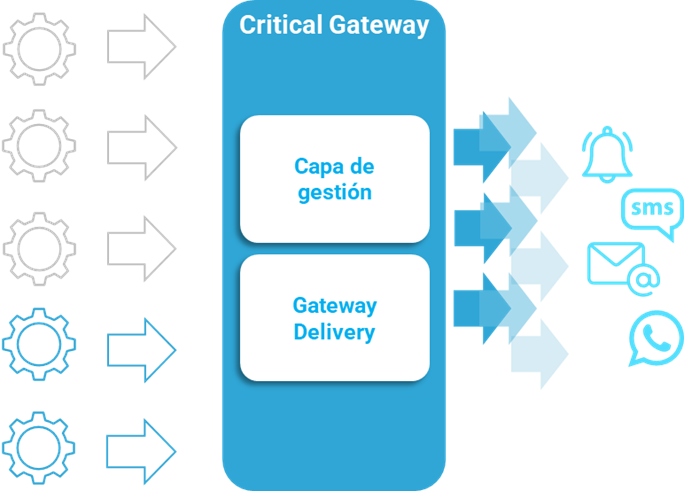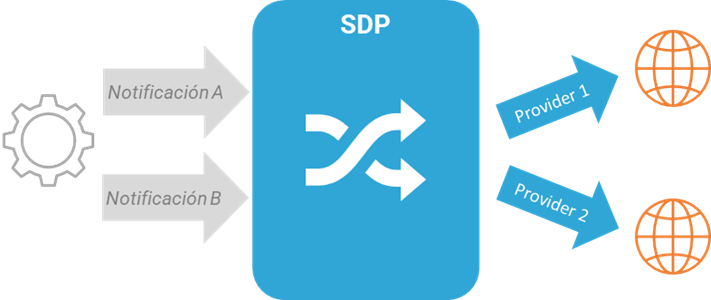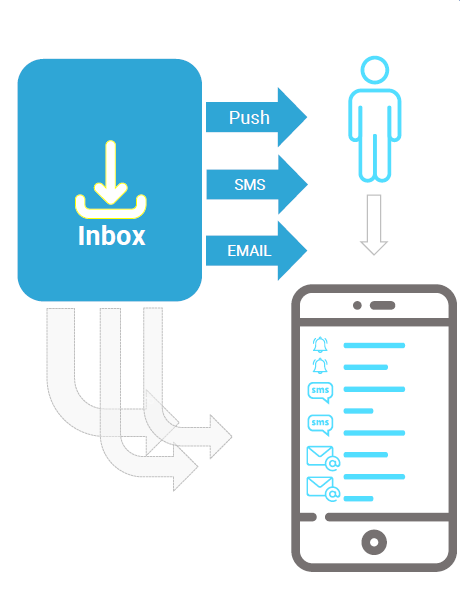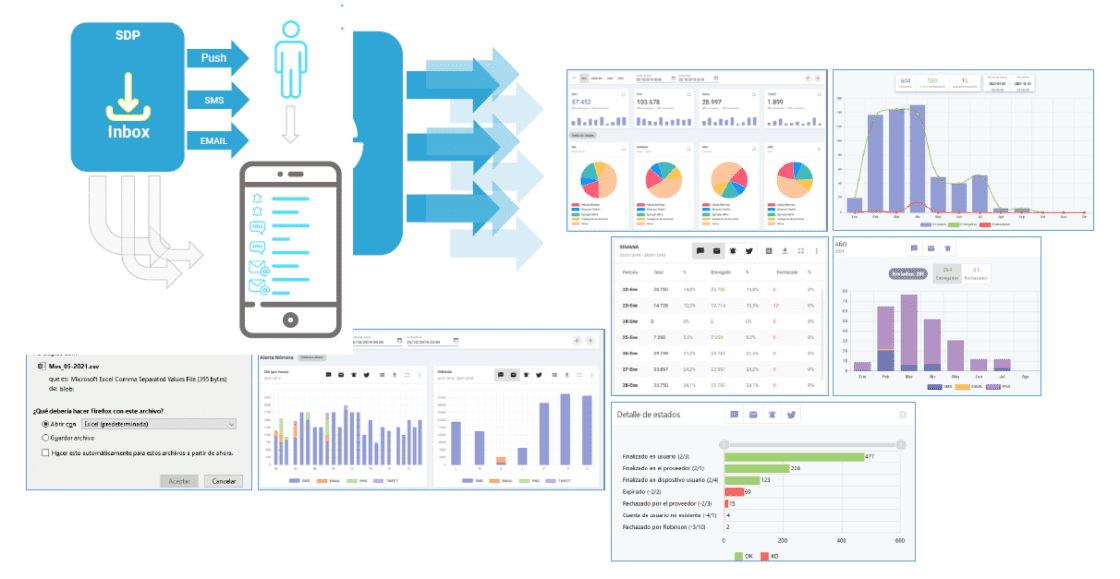
In the fast-paced world of modern banking, notifications have emerged as a vital communication channel between banks and their customers. However, while these notifications are essential, ensuring timely and error-free delivery has become an increasing challenge.
Real-time delivery of critical banking notifications is now more than a convenience; it’s an expectation. Banks are under constant pressure to ensure that every notification, especially the critical ones, reaches its intended recipient.
Given this landscape, solutions that can guarantee the delivery of these notifications are more valuable than ever. In this article, we’ll explore how Latinia Critical Events Gateway stands out as a pivotal solution to this challenge and how banks can make the most of it.
Notifications in Modern Banking: An Absolute Necessity
The digital age has reshaped how we operate across all sectors, and banking is no exception. With the rise of online banking and mobile apps, physical interactions between the bank and the customer have dwindled. However, this has led to an uptick in digital communication, where notifications take center stage.
The Importance of Notifications
Notifications serve as a bridge between banking institutions and their clients, fulfilling multiple purposes:
- Transparency: They inform clients about completed transactions, ensuring customers know all activity within their accounts.
- Security: They alert users about potential suspicious activities, enabling swift action to prevent fraud.
- Engagement: By keeping customers informed about offers, promotions, or policy changes, they strengthen the bank-client relationship.
Challenges in Notification Delivery
The exponential growth of critical notification processes, like OTP (One-Time Password), has introduced notable challenges:
- Volume: With millions of daily transactions, the sheer volume of notifications can be overwhelming.
- Infrastructure: Banks require robust and scalable systems to handle and dispatch notifications seamlessly.
- Channel Diversity: Clients engage with their banks through multiple channels, such as SMS, email, mobile apps, and more. Each channel has its unique set of challenges concerning delivery and format.
Facing these challenges, banks encounter several issues and limitations that need overcoming:
- Technological Obsolescence: Many architectures, originally designed as internal developments, now grapple with becoming outdated. Created in an era before the cloud and microservices revolution, these solutions can’t match the efficiency and flexibility of contemporary technologies.
- Incompatibility with New Standards: Traditional frameworks often struggle to adapt to current architectural and operational efficiency standards. This inflexibility is more pronounced during the migration process to cloud-native solutions.
- High Maintenance and Evolution Costs: Technological advancements, combined with the introduction of new channels and shifting business demands, make maintaining and updating these older systems costly in both time and financial resources.
- Outpaced Legacy Architectures: Growing scalability, availability, and continuity needs have outstripped legacy architectures. With notifications playing an increasingly critical role in banking operations, these systems can’t ensure the efficiency and reliability that modern banks demand.
- Rigid and Static Logic: Many older systems have logic hard-coded at the software level, lacking a suitable business interface. This leads to static solutions unable to swiftly adjust to new demands. Such rigidity prevents banks from agilely responding to evolving market demands.
Latinia Critical Events Gateway: Optimum Reliability in Banking Notifications
Issuing notifications in the banking domain is no minor task. The implications of failing in this duty can be severe, ranging from deteriorating client relations to potential regulatory penalties.
This is where Latinia Critical Events Gateway comes into its own, proving itself as a trusted and pivotal solution for the sector.
What is Latinia Critical Events Gateway?
Latinia Critical Events Gateway is a scalable infrastructure HUB for the unification, control, and centralized management of a bank’s notification processes. The platform has been tailor-made to manage and ensure the delivery of real-time transactional banking notifications.
Key Features
Latinia offers a suite of functionalities crafted to enhance and secure client communication within the banking realm. Among its standout features are:
- Multichannel Inbox: Offers unified access to all notifications, seamlessly integrating them into mobile banking apps while ensuring the confidentiality of the content.
- Multi-provider Management: It centralizes the handling of various channel providers. Its advanced system ensures real-time and reliable communication: setting priorities, managing reconnections and retries, redirections, load distribution, channel switches, audits, and more.
- Adoption and Activity Metrics: The platform equips banks with tools to analyze service behavior, offering an in-depth view of client-service interaction.

Beyond Just Notifications
What sets Latinia Critical Events Gateway apart is its advanced service management. It does more than just send notifications; it sets priorities, conducts smart retries, and ensures content confidentiality.
Its architecture can be deployed on On-Premises platforms or based on microservices. It allows efficient deployment on On-Premises orchestrators (like Openshift) or public clouds.
Furthermore, it acts as an enabler for applications, overseeing the entire notification process, from message creation to its delivery, ensuring full traceability.
This ability negates the need for applications to access client contact details directly. Instead of needing specifics like a phone number or email address, an app just needs a unique client identifier to send a notification.
This approach not only boosts efficiency by reducing required information but also strengthens the privacy and security of client data.
Architecture, Connectivity, and Interoperability
Latinia Critical Events Gateway stands out for its robustness and flexibility, making it a top choice for diverse banking applications and associated services.
A hallmark of Latinia is its standardized connectivity. Instead of relying on proprietary solutions, Latinia embraces universal standards such as WS-REST, JMS, and Kafka. This ensures smooth adaptation to existing messaging formats.
Furthermore, it has the versatility to support batch dispatch through files, ensuring seamless transition and integration with pre-existing systems.
Focusing on adapters, their design revolves around security and service quality, reflected in features like:
- Authentication and Authorization: Ensures safe access and usage of resources.
- Redundant Connectivity: Avoids communication interruptions between applications and the platform.
- Queuing and Resending: Safeguards against potential service dropouts.
- Prioritized Communication Management: Independent security for each adapter, with each operating in isolation, ensures processing level independence.
- Load Balancing: Prevents overloads from providers, upholding service stability.
Channel Provider Connectivity
When connecting to channel providers, Latinia Critical Gateway’s adaptability is remarkable. Not only has it been tailored to over 40 different messaging service providers such as SMS, EMAIL, and Push, but it can also directly connect with proprietary providers like Apple, Google, and Huawei.

Moreover, Latinia Critical Events Gateway ensures the maintenance and evolutionary adaptation of the provider interfaces, ensuring the platform stays current with the latest innovations and standards.
Latinia goes beyond mere connectivity. It’s designed to offer optimized and adaptive management of channel providers, ensuring high-quality and reliable message delivery:
- Multi-Provider Management: Providers’ free choice and coexistence are key value-adds. Banks are not limited to a single provider; they can select and coexist with multiple ones best suited to their needs.
This is further augmented by selecting specific providers per service, offering unmatched flexibility in communication management.
- Autonomous Connection Management: Latinia Critical Events Gateway boasts advanced tools that refine delivery management. It sets prioritization levels for provider delivery, ensuring the most critical messages take precedence. In the event of interruptions, automatic reconnection policies get activated.
If a primary provider fails, the system can automatically redirect to an alternative provider. If the provider supports it, establishing redundant connections further amplifies system reliability.
- Communication Persistence Management: A challenge in communication is ensuring messages reach their destination, especially during network interruptions. Latinia ensures the storage of all undelivered messages, triggering resending processes when needed.
Communication persistence is paramount, ensuring no loss of messages, regardless of circumstances.
Message Processing in Latinia Critical Events Gateway
The strength of Latinia Critical Events Gateway lies in its tailored approach to each notification. It’s not just about sending messages randomly but about applying specific rules depending on the service to which the message is tied.
This includes considerations such as delivery time, priority, and even channel selection, whether determined by the customer or the bank.
Automatic Adoption of the Push Channel
One of the key innovations is the automatic adoption of the Push channel. With Latinia, SMS messages can automatically shift to the Push channel without modifying the sending application. This feature results in a significant reduction in costs associated with sending SMSs.
Handling of MO Messages
The system also adeptly manages incoming or MO (mobile-originated) messages. Upon receipt, Latinia Critical Events Gateway can auto-route them to the appropriate business applications. Moreover, it auto-manages keys linked to each service, and if an error is detected, it can send an automated response.
Adaptation and Customization
Lastly, one of the foundational pillars of message handling in Latinia Critical Events Gateway is its adaptability and customization capabilities. Thanks to dynamic templates, the system can adapt a notification to any channel, customizing it according to the recipient’s profile and even adding additional content if required.
Key Features of Latinia’s Critical Events Gateway
Financial Sector Expertise
With 20 years of specialization in the financial sector, Latinia has established itself as a leader in the management of transactional banking notifications.
Service Continuity
Latinia Critical Events Gateway stands out for its ability to ensure the delivery of critical messages through automatic channel hopping policies. If, for some reason, a Push message cannot be delivered or a read confirmation isn’t received within a specific time, Latinia automatically switches to the SMS channel.
Similarly, the platform automatically redirects the message to the Push channel if an email message can’t be delivered. This ensures that the information reaches the recipient, thus reinforcing reliability and effectiveness in communication.
Confidentiality and Traceability
Latinia Critical Gateway prioritizes privacy and security in notification delivery through its multichannel inbox. The message content remains isolated and protected, regardless of the channel provider used.
It also facilitates message synchronization across multiple customer devices, especially with banking apps.
One of the highlighted features is the traceability of the Push channel, allowing monitoring of message receipt and reading.
Unified Alerts
The solution provides a consolidated alert system through its Inbox feature, allowing all notifications to be grouped in a single repository, regardless of the delivery channel used.
This ensures a consistent and smooth user experience, as automatic synchronization is done between all customer devices and Online Banking.

Traceability and Metrics
Latinia Critical Gateway offers advanced analysis tools, allowing banks to get a detailed view of all aspects related to notification services, from global conversion metrics to specific details of each message.

Benefits for Banking Institutions
Latinia Critical Events Gateway has been specifically designed to address the inherent challenges of banking notifications. Here, we explore some of the key advantages and benefits it offers banks, transforming and optimizing their communication with customers.
Banks that previously struggled with communication inefficiencies and dependence on a single channel have seen significant improvements in notification delivery and have expanded their communicative reach.
By adopting Latinia Critical Events Gateway, banking institutions enhance the customer experience by offering faster, more reliable, and more secure notifications.
Moreover, the system’s adaptability allows banks to keep pace with technological trends, such as migrating to cloud solutions and architectures based on microservices.
Lastly, thanks to detailed metrics and analysis tools, financial entities can continuously adjust and improve their communication strategies based on real data and past performances.
In conclusion, Latinia Critical Gateway not only provides a solution for the current communication challenges in the banking sector but also prepares entities for the future, equipping them with the necessary tools and capabilities to adapt to an ever-evolving technological landscape and changing customer expectations.
How to Integrate Latinia Critical Events Gateway into Existing Banking Infrastructure
Integrating modern solutions into existing banking systems may seem daunting, but Latinia Critical Gateway has been designed with adaptability and flexibility in mind to ensure a smooth transition.
- Modular Architecture: Latinia Critical Events Gateway operates on a microservices-based architecture. This means that banking entities can choose and implement only the modules they require, facilitating gradual integration and reducing disruption to existing systems.
- Compatibility with Legacy Systems: Recognizing that many banks still operate with older systems, Latinia Critical Gateway is designed to be compatible with these legacy systems, allowing seamless integration and leveraging existing technological investments.
- Cloud and On-Premise Solutions: Latinia offers the flexibility to deploy its Critical Events Gateway either in the cloud or on the bank’s premises, providing options to adapt to different IT requirements and strategies.
Key Steps and Considerations for a Successful Integration
- Needs Assessment: Before beginning the integration, it’s essential for banking entities to assess their communication needs and goals. This will help determine which functionalities of the Latinia Critical Gateway are most relevant to their operation.
- Detailed Planning: Once needs are identified, it’s crucial to develop a detailed implementation plan, which includes testing, target dates, and contingencies.
- Collaboration with the Latinia Team: The Latinia team possesses the knowledge and experience to ensure project success. Collaborating with them will greatly assist in addressing potential issues and optimizing the process.
- Testing: Before full implementation, it’s essential to conduct thorough testing to ensure all systems work correctly together and to identify any potential issues.
- Training and Support: It’s important that the bank’s team is trained to use and manage Latinia Critical Gateway. Latinia offers ongoing support, ensuring that questions or issues are addressed promptly.
- Continuous Evaluation: Once the solution is implemented, it’s vital to monitor and evaluate its performance regularly. The Latinia Critical Events Gateway offers analytical tools that can help pinpoint areas for improvement and ensure optimal communication with clients at all times.
Conclusion
In the era of digitization and instant communication, banking institutions have the responsibility to choose solutions that not only allow them to stay at the forefront but also protect and strengthen their relationship with customers.
Latinia Critical Events Gateway, with its innovative approach and proven track record, emerges as the optimal choice for banks looking to transform and secure their communication now and in the future.
Interested in learning more about Latinia Critical Events Gateway? Contact us, and an expert will address all your questions and advise you on the best solution for your case.
Categories: Customer Experience
